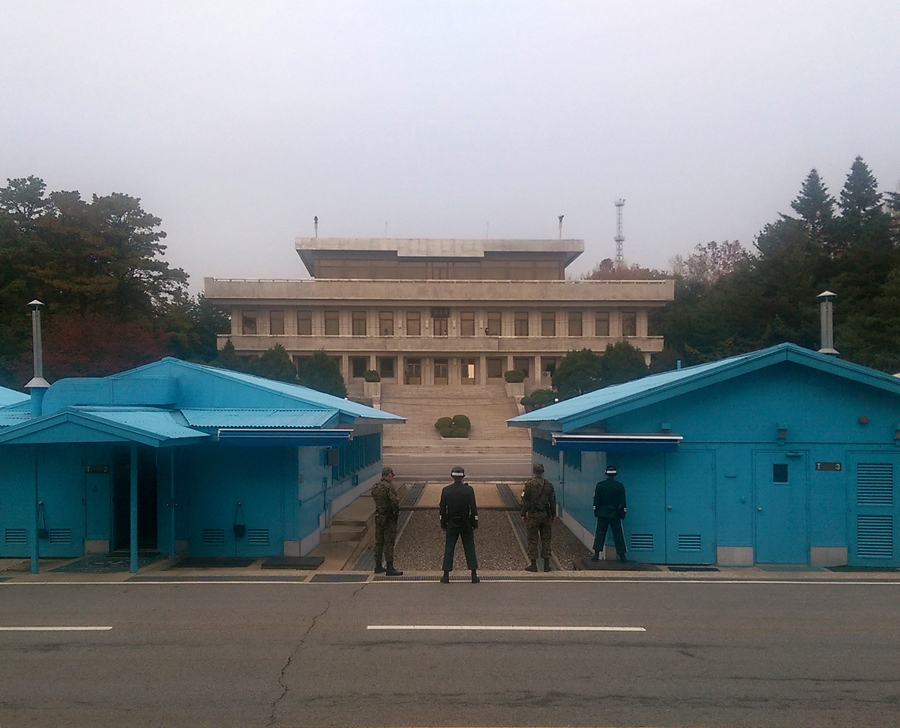United Nations-blue is a smokey blue. An odd unsaturated blue that embodies a midcentury design sensibility (it was originally chosen for lapel pins for the first meeting of the UN, in 1948). It is, to quote the organisation, ‘the opposite of red, the war colour’, but its symbolism also carries with it the colour of our planet. It’s the colour of a pale winter sky. Pantone 279 is a 92 percent match.
But however you choose to describe it, it’s a strange colour for curtains. Yet here they are, stiffly pleated hessian panels, the kind of fabric in a Photo-Me booth, hung over the tiny patches of glazing they try to obscure.
But then these are no ordinary curtains. Rather than the product of an interior designer’s ‘mood board’, they are the result of geopolitics, of the history of the twentieth century, the result of 65 years of Cold War politics.
These are the curtains that hang in a Portakabin-type structure positioned directly over the border between North and South Korea in the Joint Security Area (JSA), the point of contact between two countries that are still officially at war.
The building – the Military Armistice Commission Conference Room (MAC), to give it its full title – is the fulcrum of a complex spatial choreography orchestrated around military aggression and diplomatic protocols.
The border is marked by a line of concrete slabs that run midway between two buildings facing off against each other. On the southern side is Freedom House. Despite this overblown propagandese (endemic, at least on the southern side, where a village in the northern sector of the DMZ is dubbed ‘Propaganda Village’ while a southern equivalent is, of course, ‘Freedom Village’), it looks like a regional airport building displaying the strangely formless quality that is the result of all the freedoms of corporatedesign decisions and market-led construction practices. On the northern side is a sober classicalmodernist pavilion, an authoritarian, austere form of architecture. In other words, both structures come straight from central casting.
The border passes right through the centre of the MAC building, and it’s the axis around which the interior is arranged. Inevitably this creates a conceptual intensity, despite the hut’s banality (blue curtains excepted). A table sits on the line of the border, glossy-laminated in mahogany-e.ect. Seats are arranged on either side, allowing offcials to remain notionally within their own space during negotiations. Microphones – apparently on, 24/7 – sit on the exact borderline. At either end is a door, locked by key from the inside to prevent unauthorised access from either side.
The strange interiority of the hut is unique. The room is a kind of thickening of the notional line of border that allows the abstract idea to be occupied
This strange interiority of the MAC hut is unique. It sits not only within the JSA but within the Demilitarized Zone too: a 4km-wide strip of land that runs the entire width of the Korean peninsula. Within these (roughly) 100,000 hectares is the MAC room (something like 4 by 10 metres), a space within like a trick compartment in a magician’s prop. The room is a kind of thickening of the notional line of border that allows the abstract idea to be occupied. The discussions that take place here are the discussions that have constructed the border itself, and this room is the place where the mechanics of the border condition can be maintained, adjusted and tuned. This space within the border, in other words, is the space in which the border itself is constructed.
If the MAC and its strange interior are the product of the Korean peninsula’s own specific history, so too are all borders. The notional edge of a nation is an expression of that nation’s own self-identity. It’s where the politics and myths of a nation are made real. It’s at the literal extremity of a state that its identity is articulated. And at their most extreme, these borders are precipitated as separation walls that divide places such as the West Bank, that run along the Greece–Turkey border in Cyprus, that form parts of the Mexico–United States border and so on. The same gesture that slung Hadrian’s Wall across the northern limit of the Roman Empire.
Even the most liberalised idea of a border, say the ones you can cross without a passport (for EU citizens, at least) from one EU member state to another, is an expression of a political idea. The very same lines that history has etched into the landscape, over which blood has been spilled for generations, are now lubricated and covered over by the ideology of free movement. The absence of border, in other words, is as much a defining act as the highly policed border. But that a border is a fundamentally architectural construction is worth remembering as rising waves of European nationalism lobby to bring stiffer controls aligning with their own idea of nationhood, at the same time as globalisation and multinational corporations are eroding the very idea of the nation state.
This article was first published in the Jan & Feb 2015 issue.
